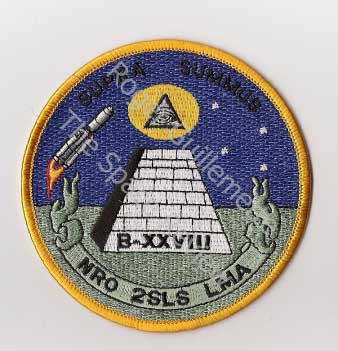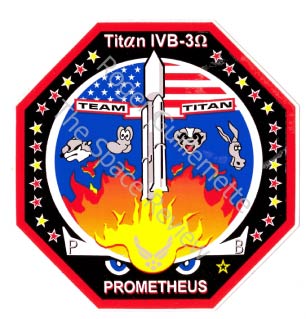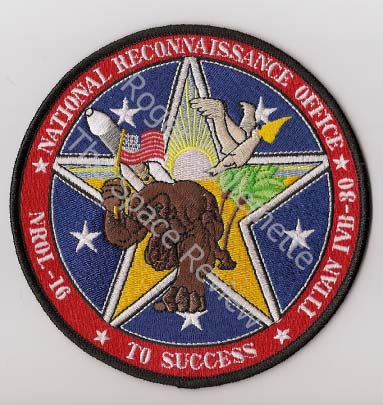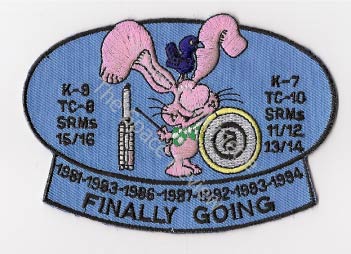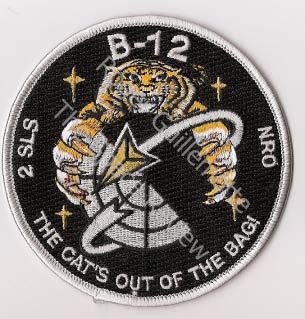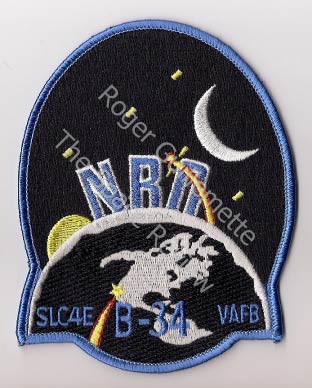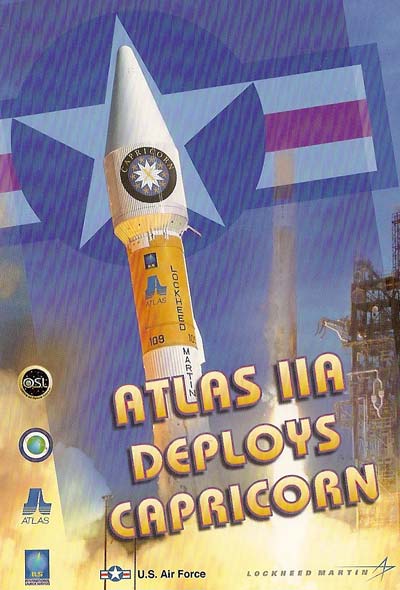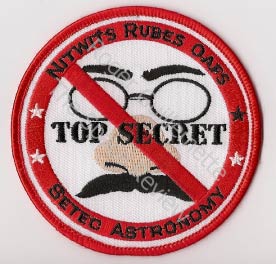Secrets and signsHomer Simpson’s webpageSometimes the people who produce the patches get a little carried away with cramming them with so many symbols that it looks like Homer Simpson’s infamous webpage, featuring everything from a flying toaster to a dancing Jesus. There are a couple examples of this, and one of them is very intriguing. Easily the most perplexing, bordering on bizarre, example is the patch for the launch of Titan 4 B-30 on April 29, 2005, the last Titan 4 launch from Cape Canaveral. This launch was believed by independent observers to carry a fifth and possibly final Lacrosse radar imaging satellite and a separate payload patch exists for this launch as well. The logo for this launch contains so many symbols and possible hints that it is difficult to determine which of them are inside jokes, abstract symbols, or if any are hints about the payload. The patch is dominated by a Greek omega symbol. Because this was the final Titan launch for the East Coast, the symbolism is obvious. A glaring pair of blue eyes—also featured prominently on several other Titan/NRO launch patches (such as the patch for the B-36 launch, which carried an entirely different kind of payload)—hint at the payload’s clandestine mission. The Air Force symbol is at the bottom of the Titan’s flames. Much less obvious are other symbols on the patch:
Appropriately, Prometheus was the son of Iapetus (one of the Titans) who stole the sacred fire from Zeus and the gods—a fitting metaphor for the last Titan to be launched from Cape Canaveral.
There was also a payload patch produced for this mission. It is far less cluttered than the rocket launch patch, but still somewhat mysterious. The patch contains five stars inside the border, indicating the fifth Lacrosse launch. Notably, it did not feature owl eyes like two previous Lacrosse mission patches; however, it did feature a pelican, whose golden beak could be interpreted as representing the radar satellite’s golden dish.
But the patch also features some odd elements. One is a gorilla carrying an American flag. What this symbolizes is unknown, although the remake of King Kong did premiere that same year. But another element of the patch is easier to decipher, even if it is not so easy to understand. The palm trees and the brilliant sun are also found in numerous patches for the satellite ground station on the island of Diego Garcia in the Indian Ocean. Clearly the satellite has some connection to that ground station, although what is still unknown.
A patch that is almost as cluttered as the B-30 patch is the patch for the launch of Titan 4 K-7, which lifted off on May 3, 1994 from Cape Canaveral. That patch contains many elements that are easy to decipher, but also one that is highly intriguing. This rocket became notorious when it sat on the launch pad for 1,054 days. During that long down-time, pad workers had to swap out major rocket components, either because they suffered problems or because they had exceeded their allowed time exposed to the Florida heat, humidity and salt air—damage so severe that the solid rocket boosters had to be removed and replaced not once, but twice.
The launch patch reflects this mission's tortured history. On the left are the numbers of the original Titan 4 core stage, K-9, and Centaur, TC-8, as well as the first pair of Solid Rocket Motors, numbered 15 and 16. On the right are the numbers of the final core stage and Centaur, K-7 and TC-10, as well as the second pair of SRMs, numbered 11 and 12, and the final pair, numbered 13 and 14. The patch also contains a pink rabbit with a blue bird (the blue bird of happiness?) on its head, probably symbolizing the rocket and either the Centaur or the payload. The rabbit is probably modeled on the Energizer Bunny, whose motto “Still going!” is reflected in the patch’s motto “Finally going”. One interpretation is that the Energizer Bunny is standing next to his drum with the number eight on it. An alternative interpretation is that the rabbit is standing next to what is apparently a hoop of the kind that circus performers make dogs or other animals jump through (the rabbit’s baton is a giveaway that this is a performance of some kind—perhaps the bird is meant to jump through the hoop). The number 8 appears on this hoop. Why an 8? This was the eighth launch of an intelligence payload to that particular orbit. Independent observers and publications like Aviation Week & Space Technology had designated the first launches to be Jumpseats, and there were six successes and one failure. For this launch, which some sources later said was named Trumpet, those involved with the rocket were hoping that the eighth satellite would successfully jump through the hoop. But the most intriguing aspect of the patch is a series of dates at the bottom above the words “Finally Going”: 1981, 1983, 1986, 1987, 1992, 1993 and 1994. The first four years all predate the Titan 4 program and therefore cannot represent the rocket. The obvious conclusion is that these dates represent the original launch dates for the payload. In other words, the payload that was finally launched in May 1994 had originally been scheduled to launch as early as 1981. Air Force officials admitted that the spacecraft should have flown on a Titan 4 transported to the launch pad in June 1991—almost three years before its eventual launch. Problems with the Titan (and reportedly exacerbated by an incessant stream of engineering changes requested by the Air Force) forced the payload to be transferred to other Titan components, resulting in a prolonged and very costly launch campaign. The problem with the interpretation that this was a 13-year-old satellite that had spent all its time in storage is that the size of the Titan 4’s payload shroud implied that this was a large payload, bigger than anything placed into orbit on an expendable launch vehicle. Could this payload have originally been scheduled for launch aboard the Space Shuttle in the early 1980s and then been repeatedly delayed due to problems with that vehicle? Or is some other interpretation possible? The cat from outer spaceOne of the important clues to a satellite’s mission is its relationship to previous satellite launches. Independent satellite observers look for patterns in classified satellite launches. Did the satellite go into geosynchronous or low Earth orbit? What was its inclination? What was the type of booster it required and the size of its payload shroud? As many of the earlier examples demonstrate, independent observers have determined that a certain number of satellites of a specific type have been launched into orbit, and this number frequently corresponds to the number of stars in a mission logo or patch. A big problem arises, however, when there is no obvious pattern, indicating a unique satellite payload. The most intriguing of these is USA-144, which was launched on May 22, 1999, on a Titan 4 at Vandenberg Air Force Base.
American military satellites are given numerous different designations by the US military to serve different cataloging requirements. One system that the military has used since 1984 labels the satellite as USA followed by a number. Thus, USA-144 was the designation applied by the American military to the 144th military satellite placed into orbit since the numbering system was implemented. The satellite used a unique 15.2-meter (50-foot) launch shroud for the Titan 4 and was launched into a unique orbit. That is the extent of what independent observers know about it. However, they have been unable to optically track it since soon after its launch and suspect that it is a unique stealth satellite whose original predecessor was launched on the Space Shuttle in 1990 and designated Misty. The observers believe that Misty is a photographic reconnaissance satellite that is largely invisible both to naked eye and radar observation from the ground. The patch for this launch was also unique. Both the patch, and a logo printed on T-shirts sold at Vandenberg, depict a tiger with the Earth in its claws and the phrase “The cat’s out of the bag!” Whether this is a generic reference to finally getting the payload off the ground, or if the tiger actually has a hidden symbolic meaning for the program (like the dragons), remains unknown. Another mystery is why the patch contains four stars, whereas the tee-shirt logo contains only three.
And the sky full of starsSometimes patches for classified satellite launches contain symbols that are obviously hints about the payload, but which are still difficult to decipher without better information. On October 5, 2001, the NRO launched a classified satellite atop Titan 4 B-34 from Vandenberg Air Force Base. The rocket had a 20.1-meter (66-foot) payload shroud and headed for a sun-synchronous, polar orbit inclined 97.9 degrees to the equator. Satellite observers speculated that this was an Advanced KH-11 type photo-reconnaissance satellite. The NRO produced a patch for this launch that depicts a satellite that looks somewhat like the Hubble Space Telescope in a polar orbit—a clear tip-off to the payload. But there are possibly two other hints in the patch as well. One is the presence of four other objects above the Earth, each the same color as the satellite. Could these be four earlier satellites of the same type? Another hint may be the crescent Moon in the upper right. Is this merely artistic, or does it contain some symbolism attached to the program?
Starting in 1996 the NRO changed a four-year-old policy and began to acknowledge that it was conducting satellite launches. But an Atlas 2AS launched on January 29, 1998 from Cape Canaveral debuted a new policy of occasionally naming the launches after constellations. The first launch also had a logo painted on its side and a name, Capricorn. Although independent observers initially speculated that this was actually the payload’s name, the NRO stated that it had adopted the policy of naming its Atlas rocket launches after constellations. Occasionally Titan 4 launches have also received mission names (as opposed to the names often applied for the rocket and Centaur), but more Atlas launches have been named: Capricorn, Gemini, Aquila, Ursa Major, Nemesis, Canis Minor, Libra, Pyxis, and Scorpion. The Capricorn launch remains perplexing. It entered an orbit similar to that used by both the SDS (communications) and Trumpet (signals intelligence) satellites. Aviation Week reported at the time that it was a unique payload type, although the magazine is not infallible. Perhaps an important clue can be found in the Capricorn logo on the payload shroud: 10 stars, as well as the Roman numeral X. Unfortunately, this does not fit either the number of speculated SDS or Jumpseat/Trumpet payloads, although it does come close to the latter: there were six Jumpseat successes and one failure, and three successful Trumpet launches. If those who produced the patch were counting only the successes, then the Capricorn launch would have been the tenth successful launch of this type of satellite (although they merely assumed that it would be successful). But if that was their calculation, what explains the fact that the first Trumpet launch featured the number eight in its patch?
SneakersNot every classified mission patch has a hidden meaning. After the December 5, 2000 launch of an Atlas 2AS rocket from Vandenberg, Lockheed Martin issued a press release that explained why the launch had been named Ursa Major and featured a cartoon bear illustration on its nosecone. “The NRO designated this as its ‘Great Bear’ Mission, and the fairing of the Atlas rocket carried a drawing of a bear designed by a Virginia student, Samantha Wingo. The mission commemorates the late Daniel M. Potter, who worked at the NRO as an engineer and who was an advocate and supporter of the NRO’s Cub Run Partners in Education Program. The Ursa Major constellation, the Great Bear, was selected as the design theme because it complemented Cub Run’s mascot, the bear cub.” Some of the patches discussed above are straightforward. But others indicate a silly or occasionally mischievous sense of humor. This is actually fairly common for military patches and there are in fact myriad examples of this in rocket culture, patches that feature cartoon characters such as Bart Simpson, Ren and Stimpy, and Bill the Cat. Then there are the patches that have a darker sense of humor.
One non-space patch that illustrates the dark sense of humor of military personnel was produced for one of the Air Force’s annual Guardian Challenge competitions. Guardian Challenge is a four-day competition hosted annually at Vandenberg Air Force Base to test the wartime readiness of Air Force Space Command specialists in spacelift, intercontinental ballistic missile operations, communications, maintenance, helicopter operations, security forces, and food preparation. Each Guardian Challenge competition generally produces its own official patch. But some Air Force personnel also take it upon themselves to produce unofficial patches as well. One of these features a mushroom cloud and the phrase “Got Nukes?” underneath, a takeoff on a then popular advertising campaign by the dairy industry, “Got Milk?” But another patch, while not as dark, had a more pointed message. It featured a symbol banning a comic fake disguise of glasses, big nose, and mustache. Above this were the words “Nitwits Rubes Oafs,” a pointed allusion to the NRO. At the bottom were the words “SETEC ASTRONOMY,” a reference to the 1992 Robert Redford movie Sneakers, where “SETEC ASTRONOMY” was an anagram for “Too many secrets.” Clearly whoever produced the patch was communicating amongst a small group of his compatriots who had obviously not had a good experience with the NRO and its penchant for secrecy. There were also four stars—three white, one black—whose symbolism is unknown.
Shadow dancingAll of these examples demonstrate that for probably three decades or more it has been common for those involved in classified satellite launches to fill their logos and mission patches with all kinds of information, including exactly the kind of information that the National Reconnaissance Office will never provide to the press or in response to questions. The NRO would never confirm that Titan 4 B-28 and K-18, or B-25 and B-36, carried similar payloads, let alone comment on the type of payload they carried, yet there are all kinds of hints in their respective mission patches. And even after the attention of an article in a national newspaper in 2000, the NRO continued the practice of hinting at their satellite missions in their mission logos. Military units develop patches and logos for many reasons. In large organizations one of their primary purposes is to serve as identification. But patches and logos also help their people develop and foster a sense of identity. Within relatively small groups like the people involved with a classified satellite launch, such logos have far more to do with morale and esprit de corps than they do with identification. The in-jokes and hidden meanings are a way of communicating with each other, of taking pride in the fact that they know the secrets and others do not. In many cases these graphic messages only communicate what outside observers can figure out for themselves—for instance, that a satellite launched into a certain orbit has a specific and known mission. But the very existence of these messages is still perplexing, because the NRO has long had a policy of denying—or at least refusing to comment about—even things that are obvious to independent observers. Far more curious are the details in the patches that provide information that would never be otherwise available, such as the dates that a satellite was originally supposed to fly. Either this has escaped the notice of the NRO’s security personnel, or somebody made the decision that national security would not be harmed by showing just a little bit of leg. We have found at least a handful of other examples of patches or logos containing hints to their classified payloads and may discuss them in a future article. The few examples discussed so far raise the question of what other hints may exist for other launches, for which patches have yet to surface. The search for these clues may not be as action packed as Nicolas Cage’s quest for ancient gold in a Hollywood movie, but space geeks may find the quest rewarding nevertheless. The authors are still seeking other examples of classified mission patches, logos and emblems, and are also interested in obtaining physical examples (and not simply pictures) of some of the patches featured here and also used for other missions. And of course, they would be interested in learning what all those mysterious symbols mean. Dwayne Day can be reached at zirconic1@cox.net and Roger Guillemette can be reached at rguillemette@bellsouth.net. Home |
|
